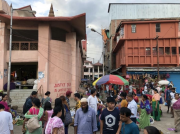
Frontier Visions: Urban Landscapes, Identity Formation, and the Battle Over Images in Imphal, Manipur
Abstract: Imphal, the capital city of the Indian state of Manipur, is a prime locale in what Sanjib Baruah has called the “battle over images” in Northeast India. Power is fragmented and contingent, with a plethora of state, armed forces, underground, and corporate entities vying for control and civilians making do in the middle. The city has undergone rapid urbanization and is also the site of tensions along the lines of class, ethnicity, generation, and gender. In this context, individuals and groups make visual interventions on both the urban landscape and their own bodies that reinscribe or contest representations put forward by the state and insurgent groups
alike. These assertions may challenge outside narratives of the city as a zone of violence and exception, complicate ideals of Manipuri identity, or reinforce divisions between tribal and nontribal or Manipuri and mayang (outsider). In Imphal, visual interventions carry significance because of multiple levels of official and social censorship that regulate speech, an insular media landscape, and the realities of complicated spatial control. Visuality is therefore a plane on which individuals communicate, assert themselves, and navigate life within the urban landscape. This project begins with an introduction that places it within the emerging field of Northeast India studies and points to some theoretical underpinnings. Then, the first chapter is a discussion of visual interventions on the city, such as graffiti, public forums, bandhs (blockades), newspapers, and commercial film. The second chapter looks at visuality on a different scale: that of the body. This chapter examines youth culture and the Korean Wave, contemporary art and performance, and hegemonic representations of Manipuri art and culture.

